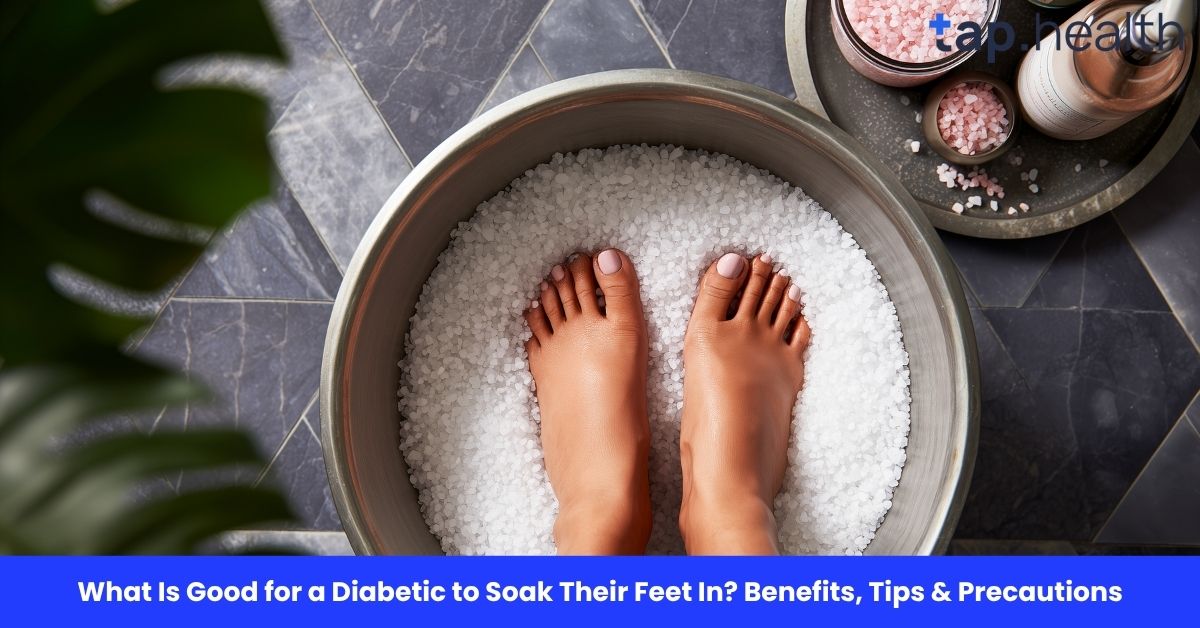Diabetes is a condition that affects millions of people around the world. Among the many complications that come with diabetes, foot care is one area that requires special attention. Diabetes can cause nerve damage (neuropathy), poor blood circulation, and slow healing, which makes foot problems more common and dangerous for diabetics. Soaking feet can be a simple, soothing way to care for your feet. But for diabetics, it’s important to know what’s safe and beneficial for your feet. In this blog post, we will explore the best options for foot soaks for diabetics, their benefits, and the precautions you should take.
Why Foot Care is Important for Diabetics?
How Diabetes Affects Feet
For diabetics, foot care is essential because high blood sugar levels can damage nerves and blood vessels, leading to problems such as poor circulation and loss of feeling in the feet. This makes it difficult for diabetics to notice injuries, infections, or blisters, which can lead to severe complications if left untreated. Diabetic neuropathy (nerve damage) and peripheral artery disease (poor circulation) are common problems that affect the feet of diabetics.
If you have diabetes, it’s important to check your feet regularly for cuts, blisters, or any unusual signs, as these can become serious issues quickly. Soaking your feet can help relax the muscles, reduce swelling, and even improve blood circulation if done correctly.
Common Foot Problems in Diabetics
Some of the common foot problems diabetics face include:
- Foot ulcers: Open sores that develop on the feet, usually due to poor circulation or nerve damage.
- Infections: Diabetic feet are more prone to infections because of poor circulation and weakened immune response.
- Dry skin and cracks: Diabetes can reduce moisture in the skin, leading to dryness, which can cause painful cracks in the feet.
- Swelling: Poor circulation can lead to fluid retention, causing swelling in the feet and ankles.
With proper foot care, including regular soaking and moisturization, you can prevent these issues or manage them effectively.
What Is the Best Way to Soak Feet for Diabetics?
Warm Water Soak
A warm water soak is one of the simplest and most effective ways to relax the feet and promote circulation. For diabetics, soaking in warm water (not hot water) can improve blood flow, relieve pain, and reduce swelling. The warmth helps to open blood vessels and allows for better circulation, which is often compromised in diabetics.
Benefits of Warm Water Soak for Diabetics
- Improves circulation: Warm water promotes blood flow, which is essential for diabetics who may have poor circulation.
- Reduces swelling: If you have swelling in your feet, a warm soak can help reduce the build-up of fluid.
- Relieves muscle tension: Soaking in warm water can relax the muscles and reduce foot pain caused by nerve damage or poor circulation.
How to Soak Feet in Warm Water
- Fill a basin with warm water (ensure the temperature is between 95°F to 100°F, or 35°C to 38°C).
- Add Epsom salt or a few drops of essential oil (like lavender or peppermint) if you want added relaxation.
- Soak your feet for 10 to 15 minutes.
- Dry your feet thoroughly with a soft towel, especially between the toes, to avoid fungal infections.
Precautions
- Always check the water temperature with your hand or elbow before soaking your feet. Diabetics may not feel hot or cold water properly due to nerve damage.
- Avoid soaking feet for too long, as prolonged exposure to water can cause skin damage and dryness.
- Don’t use very hot or cold water, as extreme temperatures can be harmful to diabetic feet.
What Natural Foot Soaks Are Good for Diabetics?
Epsom Salt Soak
Epsom salt is a popular option for foot soaks because it is known to have anti-inflammatory and muscle-relaxing properties. Epsom salt contains magnesium, which helps reduce swelling and relax stiff muscles. For diabetics, an Epsom salt soak can help with discomfort and pain, particularly in the lower legs and feet.
Benefits of Epsom Salt Soak for Diabetics
- Reduces inflammation: Epsom salt can help reduce swelling and inflammation caused by poor circulation.
- Relieves muscle pain: It is effective in easing muscle soreness and reducing foot cramps.
- Promotes relaxation: The magnesium in Epsom salt helps promote calmness and relaxation.
How to Use Epsom Salt Soak
- Fill a basin with warm water.
- Add 1-2 cups of Epsom salt to the water.
- Soak your feet for 15 minutes.
- Rinse your feet with clean water and dry them thoroughly.
Precautions
- If you have any open wounds or ulcers on your feet, avoid soaking in Epsom salt as it may irritate the skin.
- Consult a healthcare provider before using Epsom salt if you have kidney problems, as magnesium may not be suitable for people with kidney conditions.
Apple Cider Vinegar Soak
Apple cider vinegar (ACV) is known for its antibacterial and antifungal properties. For diabetics, an apple cider vinegar soak can help prevent infections and keep the skin on your feet healthy. It can also help balance the pH of your skin and reduce the risk of fungal infections like athlete’s foot.
Benefits of Apple Cider Vinegar Soak for Diabetics
- Fights infections: ACV has natural antibacterial and antifungal properties that can help prevent infections in diabetics.
- Improves skin health: ACV helps in maintaining the skin’s pH balance, keeping it smooth and healthy.
- Prevents foot odor: Apple cider vinegar can help reduce foot odor, which is common in diabetics due to sweat and poor circulation.
How to Use Apple Cider Vinegar Soak
- Mix 1 part apple cider vinegar with 2 parts warm water in a basin.
- Soak your feet for 10 to 15 minutes.
- Rinse with clean water and dry your feet thoroughly.
Precautions
- Apple cider vinegar is acidic, so it may irritate sensitive skin. Always dilute it with water before use.
- Avoid using ACV on open sores or cuts to prevent irritation.
Tea Tree Oil Soak
Tea tree oil is another natural remedy with antifungal and antibacterial properties. For diabetics, soaking feet in a solution containing tea tree oil can help fight infections, including fungal infections like athlete’s foot or toenail fungus, which diabetics are prone to.
Benefits of Tea Tree Oil Soak for Diabetics
- Antifungal and antibacterial: Tea tree oil helps prevent and treat foot infections that diabetics are at higher risk of developing.
- Promotes healthy skin: It helps maintain the health of the skin, preventing dryness, cracks, and blisters.
- Reduces itching and irritation: Tea tree oil has soothing properties that help relieve itching or irritation caused by skin conditions.
How to Use Tea Tree Oil Soak
- Add 5-10 drops of tea tree oil to warm water.
- Soak your feet for 10-15 minutes.
- Dry your feet well, especially between the toes.
Precautions
- Tea tree oil is potent and should always be diluted with water or a carrier oil before use to avoid skin irritation.
- If you have an allergy to tea tree oil, avoid using it.
Foot Soak Alternatives for Diabetics
Oatmeal Foot Soak
Oatmeal is soothing and gentle on the skin. A foot soak with oatmeal can relieve dry skin and help soothe any irritation. It is particularly beneficial for diabetics who have cracked or itchy skin on their feet due to dryness.
Benefits of Oatmeal Foot Soak for Diabetics
- Moisturizes the skin: Oatmeal helps in locking moisture into the skin, preventing dryness and cracking.
- Soothes irritation: It helps calm irritated skin, especially in the case of eczema or other skin conditions.
- Gentle on sensitive skin: Oatmeal is a natural and gentle option for diabetics with sensitive skin.
How to Use Oatmeal Foot Soak
- Mix 1 cup of oatmeal powder in a basin of warm water.
- Soak your feet for 10-15 minutes.
- Rinse and dry your feet thoroughly.
Salt and Baking Soda Foot Soak
A foot soak with a mixture of Epsom salt and baking soda can provide both exfoliation and relaxation. This combination helps to detoxify the feet, remove dead skin cells, and relieve discomfort.
Benefits of Salt and Baking Soda Foot Soak for Diabetics
- Exfoliates skin: Helps in removing dead skin and promoting smooth skin.
- Relieves foot pain: The combination of salt and baking soda soothes muscle aches and pain.
- Improves circulation: Epsom salt and warm water together promote better circulation.
How to Use Salt and Baking Soda Foot Soak
- Add 1 cup of Epsom salt and 1/2 cup of baking soda to warm water.
- Soak your feet for 10-15 minutes.
- Rinse your feet with clean water and dry them well.
Real-Life Scenario
Meet Priya, a 52-year-old woman with type 2 diabetes. She often experienced tired, swollen feet after long workdays. By incorporating a 10-minute lukewarm Epsom salt foot soak twice a week, she noticed reduced swelling and improved comfort. Priya always dries her feet thoroughly afterward and applies a light moisturizer, which helps prevent cracks and infections.
Expert Contribution
According to Dr. Anil Mehta, a podiatrist specializing in diabetic foot care:
“Diabetic patients must be cautious with foot soaks. Lukewarm water is safe, but prolonged or hot soaks can worsen neuropathy or lead to burns. Adding Epsom salts can help reduce mild inflammation, but patients should always check their feet daily for cuts, blisters, or signs of infection.”
Recommendations Grounded in Proven Research and Facts
- Temperature control is key: Water should be between 37–40°C (98.6–104°F) to prevent burns.
- Soak duration: Limit to 10–15 minutes, 2–3 times per week.
- Moisturize after soaking: Apply a diabetic-safe moisturizer to prevent dry, cracked skin.
- Avoid additives that can irritate: Strong antiseptics or essential oils without guidance can harm sensitive skin.
- Daily inspection: Check for sores, redness, or swelling, which could indicate infection.
Clinical studies confirm that proper foot care routines, including safe soaking practices, reduce the risk of diabetic foot complications and improve comfort and skin health.
FAQs About What Is Good for a Diabetic to Soak Their Feet In?
1. Can diabetics soak their feet in hot water?
No, diabetics should avoid hot water as it can cause burns or skin damage due to reduced sensitivity in the feet. Lukewarm or warm water is safer.
2. What is the best foot soak for diabetics?
The best foot soak for diabetics includes warm water with Epsom salt, apple cider vinegar, or tea tree oil. These options help improve circulation, reduce infections, and maintain healthy skin.
3. How long should diabetics soak their feet?
Diabetics should soak their feet for 10-15 minutes, ensuring they don’t over-soak to prevent skin damage.
4. Can a foot soak prevent diabetic foot ulcers?
A proper foot soak, combined with good hygiene and regular foot checks, can help reduce the risk of developing foot ulcers by promoting circulation and preventing infections.
5. Are there any foot soak ingredients diabetics should avoid?
Diabetics should avoid using harsh chemicals or overly hot water. Also, any soak with ingredients that cause skin irritation should be avoided.
Conclusion
Foot care is critical for diabetics, and soaking feet can be a great way to relax and maintain healthy feet. By choosing the right foot soak ingredients like warm water, Epsom salt, apple cider vinegar, or tea tree oil, diabetics can benefit from improved circulation, reduced swelling, and healthier skin. However, it’s important to follow the precautions and consult a healthcare professional to avoid complications. By making foot care a daily habit, diabetics can prevent many foot-related problems and enjoy better overall health.



